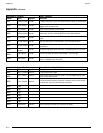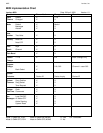
960L Owner’s Maunal Using The Reverb Program
Parameters Used in the 960L Algorithms, Continued
5-13
RearRoll
RearRvb
RShape
RSpread
RtHicut
RvbLvl
RvbPreD
Shape
Shelf
Rear Rolloff (Surround algorithms only). Like Rolloff in Stereo, this controls the cutoff frequency
of a 6dB per octave low-pass filter at the output of all processing, but affects the rear (LS and
RS) channels only. A separate parameter, FrRoll, controls the rolloff for the front (LF, C, and RF)
channels.
Rear Reverb Level (Surround algorithms only.). Like RvbLvl in Stereo, this controls the level of
the reverberant tail, but only for the LS and RS outputs. This allows their levels to be set relative
to the early reflection levels and the other reverb tails. RvbLvl is a master control for CtrRvb,
FrRvb and RearRvb.
Rear Shape (Ambient Chamber algorithm only) sets the contour of the initial reverberant-energy
growth for the rear channels. Low values produce a very rapid onset, as you’d find in a small
chamber. With larger values, the reverberation "blooms" over a few hundred msec, much as it
would in a good, Romantic-era concert hall, and the listener’s perceived position moves farther
back into the hall. See also Contour, Rspread, Shape, and Spread.
Rear Spread (Ambient Chamber algorithm only) works with RShape to control the profile of
initial reverberant-energy growth for the rear channels, stretching or compressing this contour in
time to make reflections closer together or further apart. With complex material, it may be
advisable to use a moderately high value for Shape and a moderately low one for Spread to
create a bit of space around the original signal. See also Contour, RShape, Shape, and Spread.
Reverberation Time High Cut. In real rooms, the timbre of the reverberant tail becomes darker
over time due to the air’s absorption of high-frequency sound energy. This control models that
behavior, though over a much wider frequency range. When you set the cutoff to very low
frequencies, the duration of the reverb will be much shorter than the value shown by MidRT.
Reverberation Level controls the level of the Reverberant tail, allowing its level to be set relative
to the early reflection levels. It is normally set to Full, but may be reduced for effects where pre-
echoes should dominate. In surround algorithms, this is a master control for CtrRvb, FrRvb and
RearRvb.
Reverb PreDelay sets the number of milliseconds between a sound and the onset of the
reverberations it excites, equivalent to the time of first reflection. In the algorithms that include
the Shape and Spread controls it is better to extend the time period before reverberant decay
using Shape and Spread. In general we recommend leaving the Reverb PreDelay set at the
preset value.
Shape works with Spread to control the profile of initial reverberant-energy growth. Shape sets
the envelope of the energy build-up and Spread stretches or compresses this contour in time.
Low values of Shape produce a very rapid onset, as you would find in a small chamber. With
larger values, the reverberation "blooms" over a few hundred milliseconds, much as it would in a
good, Romantic-era concert hall. Large values of Spread and Shape can create "inverse" effects
(see note under Reverse algorithm).
Shelf (Random Hall only) controls a shelving low-pass on the reverb output. It modifies the low-
pass characteristic of the rolloff control, turning it into a shelving filter. Both the pre-echoes and
the reverberation are affected. For example, if Shelf is set to –6 dB, frequencies below
approximately Roll / 2 will be boosted by 3.5 dB, while above approximately Roll / 2 response will
be flat. For realistic musical acoustics, Shelf should be set between +12 and –6 dB and Roll
should be set between 700 Hz and 1.5 kHz. While this control can occasionally be useful to
increase the apparent low frequency content of the returns, it does so at the expense of
eliminating the overall rolloff characteristic that typically begins around 2kHz. Thus it is probably
best to leave Shelf set to zero. If more LF is desired in the returns, use console equalization to
increase the low frequency content by ~3dB below 200Hz.


















